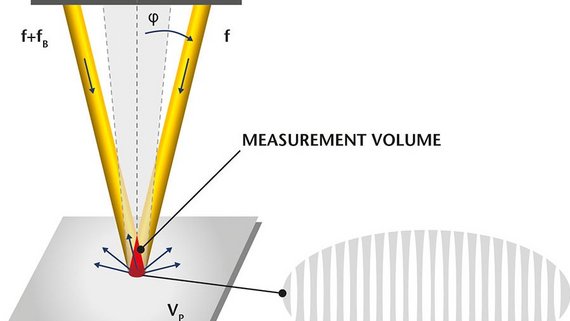
The laser Doppler velocimetry
Laser surface velocimeters work according to the Laser Doppler Principle and evaluate the laser light scattered back from a moving object or surface. Polytec’s LSVs are based on the very challenging and sophisticated heterodyne detection method. Unlike conventional non-contact methods which measure only the absolute value of the velocity, Polytec’s LSVs can also detect changes in the object’s direction and even standstill conditions. The measurement precision is not dependent on the velocity, so even very small movements can be precisely recorded.
Measuring principle of laser Doppler velocimetry
The differential Doppler technique
To perform a speed measurement on moving objects, which can in principle be of any length, you require a measurement setup with a sensor which is mounted perpendicular to the surface it is measuring on. Polytec velocimeters work according to the so-called Differential Doppler Technique. Here, two laser beams – which are each incident to the optical axis at an angle φ – are superimposed on the surface of the sample. For a point P, which moves at velocity v through the intersection point of the two laser beams, the frequencies of the two laser beams are Doppler shifted in accordance with the above formula.
Both the laser beams are superimposed in the measurement volume and, in this spatial area, generate an interference pattern of bright and dark fringes. The fringe space Δs is a system constant that depends on the laser wavelength λ and the angle between the laser beams 2φ:
Δs = λ/(2 sin φ)
If a particle moves through the fringe pattern, then the intensity of the light it scatters back is modulated. As a result of this, a photo receiver in the sensor head generates an AC signal, the frequency fD of which is directly proportional to the velocity component of the surface in measurement direction vp, and it can be said that:
- fD = vp/Δs = (2vp/λ) sin φ
- fD = Doppler frequency
- vp = Velocity component in the direction of measurement
- Δs = Fringe space in the measurement volume
The value λ/sin φ makes up the material measure for the velocity and length measurement.
The heterodyne technique
Laser surface velocimeters that work in the so-called heterodyne mode show a frequency offset of 40 MHz of one of the laser beams. This makes the fringes in the measurement volume travel with a velocity corresponding to the offset frequency fB. This then makes it possible to identify the sample’s direction of movement and to measure at the velocity zero. The resulting modulation frequency fmod at the photo receiver in heterodyne mode is:
fmod = fb + vp / Δs = fb + (2vp/λ) sin φ
The modulation frequency is determined in the controller using Fourier transformation and converted into the measurement value for the velocity vp. The length measurement is performed by integrating the velocity signal.
